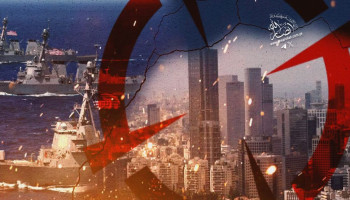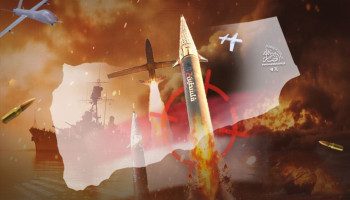A prominent analyst commenting on the state of Arab disillusionment remarked, “This disgraceful moment is unprecedented in our nation’s history. No one ever imagined that the Arab and Islamic stance would sink to such levels of abandonment and betrayal of Palestine. What the Yemenis are doing is precisely the duty that Arabs and Muslims should be fulfilling. They are single-handedly carrying out what the entire nation ought to be doing.”
Between these two extremes lies the harshest moment of confrontation, encapsulated by the previous commentary, which reflects the staggering, unacceptable reality of the situation. It also highlights the immense challenges of Yemen’s political support operations for Palestine, leaving aside the military dimension—a separate challenge the Yemenis have adeptly adapted to and mastered. This, in essence, is the price of their decision to reclaim sovereignty and freedom.
Yemen’s Support Operations
In these difficult times, with contradictions and rapid regional and international transformations, Yemen has emerged as a pivotal force in supporting the Palestinian cause. Over the past year, Yemen has taken up the banner of Palestine, effectively dismantling the traditional frameworks governing Western-Arab relations and reshaping conflict dynamics based on self-identity. Most significantly, this shift demonstrates the capacity of Arab and Islamic peoples to overcome obstacles, thwart divisions, and play a proactive role in shaping the region’s future based on a unified faith identity.
Ironically, this emergence occurred at a time when the West believed it had succeeded in exploiting internal discord to establish the Zionist entity and implement the so-called "New Middle East" project. This vision aimed to erect a Zionist state atop the remnants of Arab and Islamic entities paralyzed by fear, submission, and betrayal.
Yemen’s Identity at the Core
Scientific analyses of Yemen's support operations must connect these efforts to Yemen’s identity, rooted in the Quranic project. Without this logical and realistic linkage, any examination risks being speculative and divorced from the operations’ objective causes. Dr. Al-Buhaisi, who has studied the speeches and philosophy of Sayyid Abdul-Malik al-Houthi, states: “The secret lies with the leader. Otherwise, the masses are often subjugated extensions of their rulers’ whims.” He further elaborates that the Yemeni model stems from Sayyid al-Houthi’s wisdom and Quranic vision.
This identity was evident in Yemen’s recent operations, representing the highest support levels. These actions were not mere political stances or symbolic gestures but were escalatory steps demonstrating a deep-seated commitment to the Palestinian cause. They reinforced the notion that this is a just right, impervious to international shifts or attempts to dilute or eliminate it.
Strategic Military Developments
Simultaneously, Yemen’s operations reflect the significant advancements in its rising military capabilities. These capabilities have endured over eight years of war, encompassing more than 40 battlefronts. The deployment of the “Palestine-2” missile exemplifies this ingenuity. However, the Yemeni Armed Forces likely harbor even more formidable developments in their arsenal.
On Thursday evening and early Friday, Yemen launched two “Palestine-2” missiles within hours—a first for the nation. Analysts agree that this operation marks a new phase in Yemen’s military campaigns, embodying a production capacity long feared by the Zionist entity. The operation underscored Yemen’s readiness to break Gaza’s isolation and overcome immense pressures aimed at dissuading its leadership.
A Calculated Moment
The timing of Yemen’s operation was deliberate, coinciding with Israel’s intensified efforts to tighten its siege on Gaza. In this context, Yemen’s missiles disrupted Israeli plans, highlighting their rapid development, which not only bypasses enemy air defenses but also delivers greater destructive power.
The precision strikes caused powerful explosions in the heart of occupied territories, particularly in Yaffa, creating operational and psychological shockwaves within the Israeli entity. Millions of settlers fled to shelters, which proved inadequate, leaving Zionist officials to concede their defense systems’ failure against Yemen’s hypersonic missiles.
Alarms as Symbols of Defeat
The wailing sirens across Israeli settlements have become harbingers of terror. Zionist sources acknowledge the difficulty in predicting the trajectory or targets of Yemeni missiles, forcing early-warning systems to activate broadly, adding to the settlers’ psychological distress. These alarms now symbolize fear, heralding the devastation that follows, rather than providing reassurance.
This transformation reflects not only Yemen’s military advancement but also its growing audacity in confronting the Zionist entity, draining its resources, and exhausting its resolve. Yemen’s actions demonstrate that the conflict is no longer confined to Gaza but has expanded to include other active participants ready to bear the costs of resistance.
Strategic Persistence
Despite Israel’s ongoing preparations for a large-scale military operation aimed at deterring Yemen, the latter preempted these plans on Thursday night and Friday morning with decisive strikes. These actions disrupted Israel’s internal political and military plans and influenced its aggression against Yemen itself.
The Thursday operation, complemented by a subsequent drone strike, reiterated Yemen’s steadfast commitment to the Palestinian cause. This strategic resolve is not subject to external pressures but is rooted in Yemen’s growing technical and operational capabilities, designed to confront even the worst-case scenarios.
By once again affirming their solidarity with the Palestinian people, the Yemenis have delivered a clear message: "You are not alone." This is not just an emotional boost but a significant military and political act that dismantles Zionist objectives and fortifies the resistance against oppression in the region.







